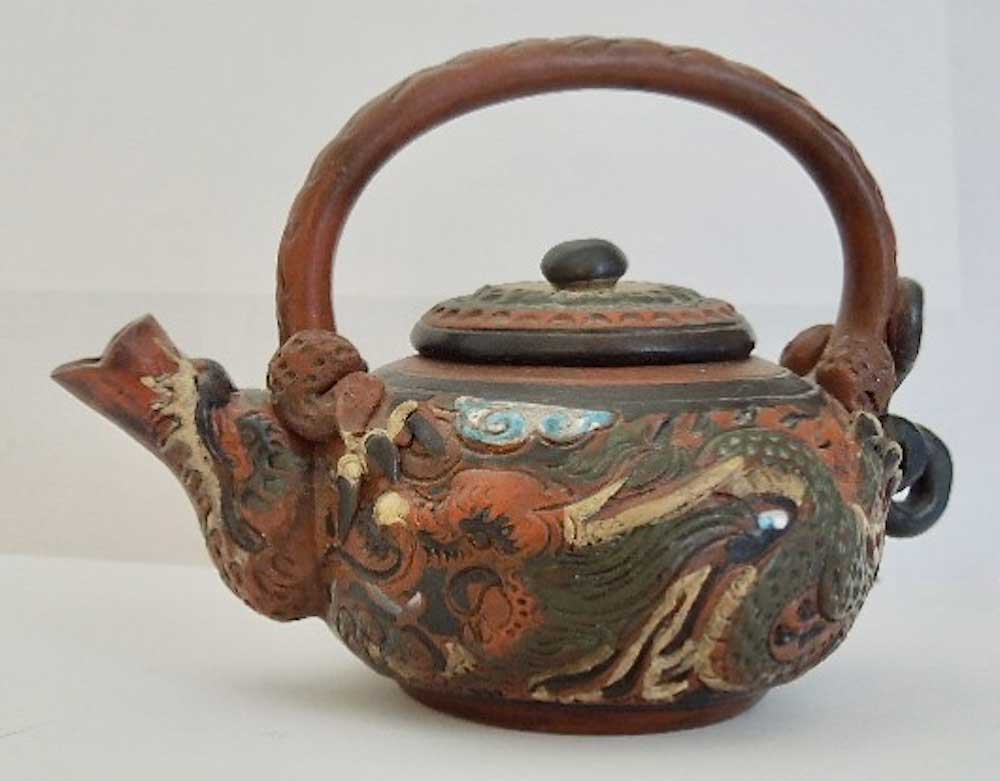May 2024
Good Eye
Collecting for teetotalers
by Peggy Whiteneck
The history of tea and its dispersion is not entirely known nor clearly understood, but it appears the first tea appeared in China at least as early as 350 BC. Eventually, tea drinking would expand across the world, to North and South America, Europe, India, Africa, and Japan.
In its earliest imported form, tea was considered a delicacy, highly prized and extremely expensive. Early tea caddies were made of wood (e.g., mahogany, walnut, and rosewood). They were equipped with lock and key to protect the precious contents.
Tea’s worldwide range led to many antique tea-related instruments for storage, brewing, and serving. Teapots came into use in China during the Ming Dynasty in the 16th century. Prior to the advent of the teapot, tea leaves were either chewed or ground into a powder that was mixed with hot water in tea bowls. The tea bag wasn’t invented until the 20th century, according to an article from NPR.
In China, tea was a celebratory and somewhat formal drink on occasions such as weddings and other family gatherings. A full tea set would include at least the teapot, teacups, tea strainer, kettle tray, and tea leaf holder.
The East India Co. in China had a monopoly in worldwide tea distribution until the 1830s and, like most monopolies, was able to name its price. Once tea started to be imported beyond China, prices began to moderate.
Teapot History
Earliest teapots from China were made of fired clay. The first European teapots were made of silver and looked like coffee pots, coffee also having reached Great Britain in the early 17th century, according to the Victoria & Albert Museum.
Porcelain teapots came into vogue later in the 17th century in China, which exported the form to Europe. Silver and other metal mounts “were also used to mask cracks or breakages to the handles, finials and spouts, caused by the perilous sea journey,” according to the museum.
By the 16th century, Japanese potters had moved the handle from the side to the top of the teapot, and most of these top handles were made of woven plant materials such as bamboo and reed. These were inherently non-durable, so most such handles are either missing or replaced with later materials.
Tea Strainers
Utensils called “mote spoons” came into vogue in the 17th and 18th centuries. Steeped tea could be poured through the perforated spoon, which would strain out the tea leaves. These spoons, which had long handles, weren’t entirely successful at keeping out the leaves from the cup. Thus, they gave way fairly soon to other forms of tea strainer that kept the leaves enclosed and away from the tea water.
Tea strainers as we would eventually come to recognize them were a 17th-century invention. They eventually came in a variety of shapes, but the earliest ones were ball-shaped. Tea strainers consist of screening to enclose the leaves, keeping them away from the hot water in which they are steeping.

Asian Teapot
This teapot with a dragon motif contains an etched mark of Asian characters in an oval outline; I find Asian pottery marks are rarely easy to decipher, so the only other thing I can say on my own is that the teapot has a distinctly Asian decorative motif! I can’t even estimate its age except to say that the absence of a country of origin in the mark probably means it was not made for export and that it probably wasn’t born yesterday. If anyone can venture a guess on this little teapot’s age and origin, I’d love to hear from you! (Image courtesy of the author)
Metal Tea Pots and Kettles
Beginning in the 18th century, teapots were often made in Sterling and Silverplate sets that included creamer and sugar and, usually, a tray. By the 19th and 20th centuries, these were often quite elaborate in design and were made for wealthy patrons to impress their guests.
The earliest example of a water heating vessel was a bronze kettle found in Mesopotamia around 3000 BC! Around the 18th century, the first cast iron tea kettles originated in Japan. These were larger than the teapots in table settings and were used primarily for heating water.
The copper tea kettle is probably the large kettle most familiar to readers. Most found in the U.S. today date from the 19th century and were handcrafted. The handle on these was often made of wood at the top to make it easier to lift the kettle when hot.
Peggy Whiteneck is a writer, collector, and dealer living in East Randolph, VT. If you would like to suggest a subject that she can address in her column, email her at allwritealready2000@gmail.com.

